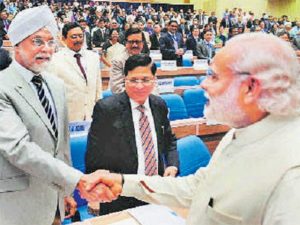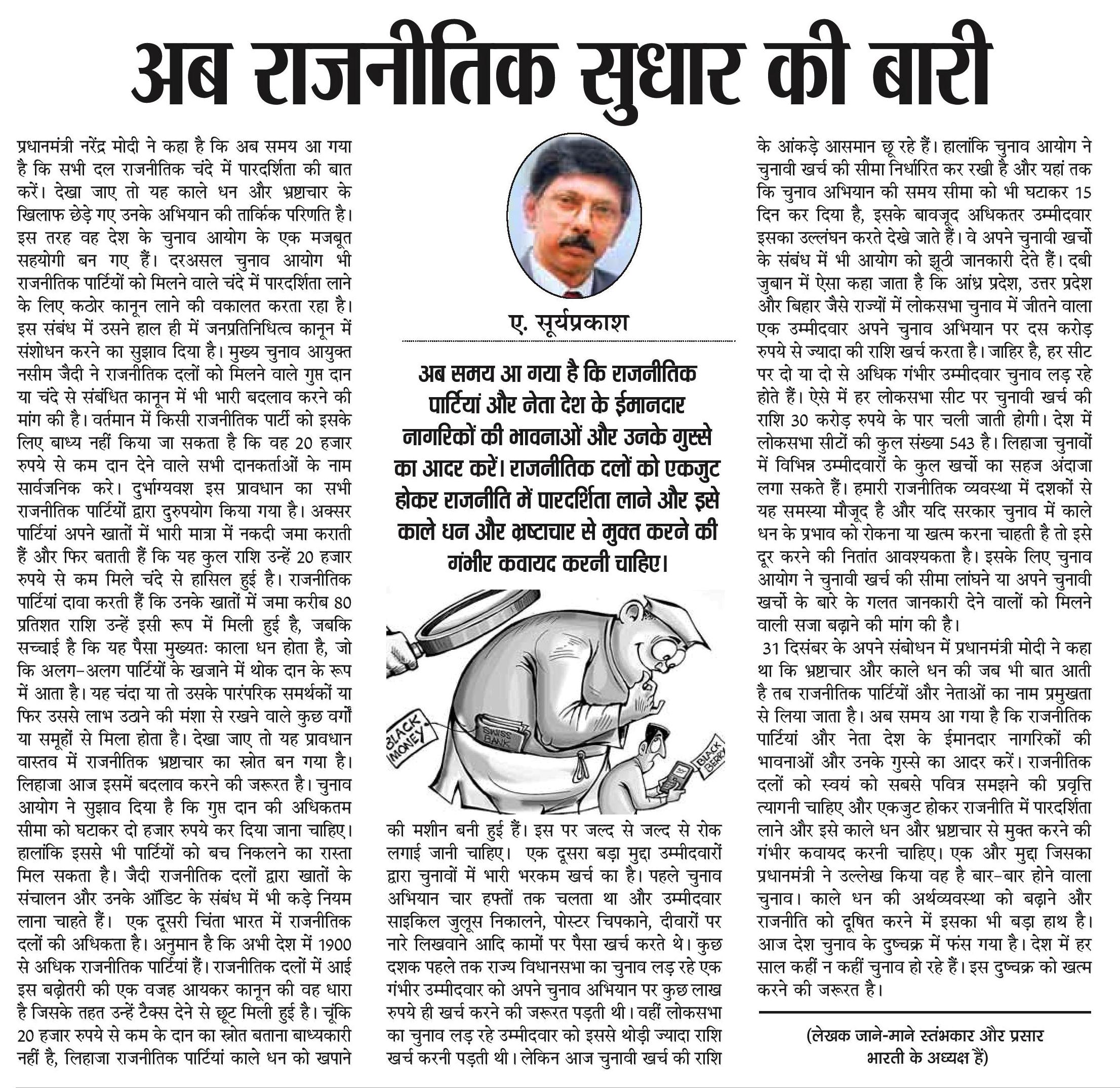
09-01-2017 (Important News Clippings)
To Download Click Here
MPs, step on the gas for road safety

However, progress on the ground is negligible. Of the 1.3 million traffic fatalities globally in 2015, India accounted for 1,48,707 persons; registering an increase of 5.1 per cent in accident fatalities between 2014 and 2015.
Reducing road fatalities will require drastic action and concerted efforts. Every hour, there are 53 road accidents, killing 17, 10.5 per cent of whom are children.
Improving road design and management with an emphasis on ensuring safety of the most vulnerable users — pedestrians and cyclists — and improving road-user behaviour must form the core of any effort to reduce road fatalities.
This will require sustained and enhanced public awareness and enforcement of laws. Improving post-crash response will help reduced fatalities.
The amendments to the Motor Vehicles (Amendment) Bill address many of these issues. Despite the urgency of the issue, the Parliamentary Standing Committee on Transport has been reviewing the Bill for almost five months now.
It needs to speed up its efforts so that it can be taken up in the Budget session. It must suggest provisions to address the Bill’s lacunae, especially on scientific investigation of accidents and data collection, penalties for faulty road design and engineering and mandatory training for all drivers.
The Bill is not sufficient to arrest the rising numbers of accidents and deaths. That calls for political will to translate the provisions of the Bill on the ground, particularly at the level of municipalities.
Urban development authorities must work with those in road safety to achieve town design that prevents a mistake on the road from becoming a death sentence.
This piece appeared as an editorial opinion in the print edition of The Economic Times.
Date: 09-01-17
The new chief justice may bridge the gap between judiciary and executive
In the middle of things
By Pranab Dhal Samanta
New Chief Justice J S Khehar doesn’t have much time in office. Yet, it may be enough to accomplish what he probably first started out to do: to explore a new middle ground between the judiciary and the executive, one determined by judicial consent and not just legislative fiat.
Everyone, including Khehar, agrees that reform and transparency in judges’ selection and appointment isn’t a bad thing. Except, should the judiciary be told how to do it?
Years of coalition governments and the lack of political consensus at crucial junctures of the evolution of the collegium system brought matters to a point where there was an unhindered erosion of any check on the judiciary.
As a result, the collegium system continued, despite not inspiring the requisite trust. But gradually, a political consensus was beginning to emerge on a legislative intervention to appoint judges. One of the first productive conversations between the BJP and the Congress post-2014 was on this issue.
Order of the Day
Yet, by the time the Khehar-led fivejudge bench ruling came, this consensus had frittered. The timing, though unintentional, was precise. The BJP’s call to not grant the Leader of Opposition status to the Congress on grounds that it hadn’t got 10 per cent seats in the Lok Sabha created new fault lines in Parliament.
The lack of generosity from the government was met with equal lack of accommodation from the Congress.
The National Judicial Appointments Commission (NJAC) order came at this particular political moment. And despite strong advice from oldtimers, the Congress leadership decided to abandon any attempt of a legislative riposte. So, round one went to the Supreme Court (SC), and Khehar was undoubtedly the leading light from there on.
Out went the NJAC and in came the Memorandum of Procedure (MOP). Simply put, GoI could influence changes in the collegium procedures, but not overhaul the system. With that ruling, the legislature took the back seat and the executive and bureaucracy came to the fore.
Round two has been playing out in that exact way legal-bureaucratic battles usually do. More drafts of technical details, leading to an impasse over filling up vacancies and creating pressure on the judiciary, especially in the middle and lower courts. The Parliamentary Committee on Law and Justice has all of a sudden developed fresh interest in the matter.
Yes, a new context is taking shape for Khehar. His response will determine the nature of the milestone his tenure will be to the judiciary, the larger constitutional balance and the underlying principles of accountability that hold it together.
The fight’s really not that irresolvable. If you take a long view of the quarrel’s technical details, the basic concept from the government-end is simple: the process must, at least, have the same rigour as that of appointing, say, a GoI secretary or any other constitutional position like a Central Information Commissioner (CIC).
In the case of secretary, ‘assessment of suitability’ is done by a committee of secretaries headed by the Cabinet secretary assisted by a panel of former secretaries. But the selection requires the final approval of the Appointments Committee of Cabinet (ACC) headed by the PM.

Similarly, for the CIC, there’s a committee headed by the Cabinet secretary to identify a panel. A similar exercise is carried out to select UPSC members and heads of other financial regulatory bodies.
The recommendations are assessed for a final decision by the selection authority. So, why can’t the SC collegium have such a layer of screening? The GoI argues that these could be former judges, legal experts or anyone suitable for the job as long as there’s some screening before it reaches the collegium. Now, why is that so important? GoI has some revealing statistics.
Take Allahabad High Court, which has close to 73,000 advocates with 10 years’ experience, of which a ballpark 25 per cent (about 18,300), would be eligible to be appointed a high court judge.
Telangana and Andhra Pradesh High Court has 1,226 advocates in that zone. One has to admit, it’s rather difficultto explore such a large field without an institutional screening process.
Else, any system could be charged with arbitrariness. And to complicate matters, the SC collegium’s rate of rejection of high court collegium recommendations is quite high: 30 per cent if you go by government calculations. Recently, the Karnataka High Court sent 10 names for as many vacancies.
Only two went through. And most of these rejections are due to ‘IB (Intelligence Bureau) inputs’, or the divergence of opinion among judges. A thorough screening process and putting down reasons of selection or rejection on record can’t be insurmountable reforms to undertake.
Yes, GoI’s insistence on rejecting a name for ‘security reasons’ does make matters uncomfortable. But mutually agreed processes can be worked out to ensure exceptionality of deploying such a provision.
The rest of the discord rests on even smaller issues, where GoI can actually back down, like setting a quota on number of Supreme Court judges appointed from the bar, or age limits for appointing high court judges. In other words, round three is truly set up for the chief justice to leave his stamp. So, eight months could prove to be a fairly long time.
Date: 09-01-17

